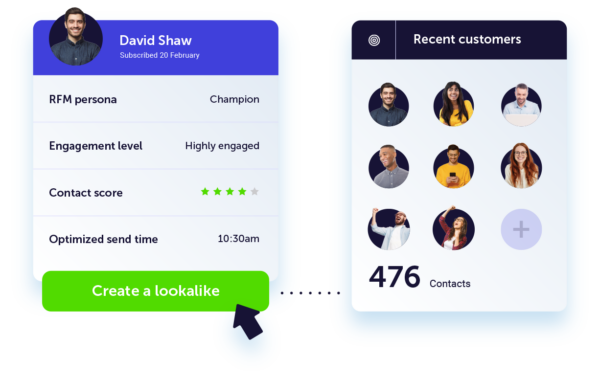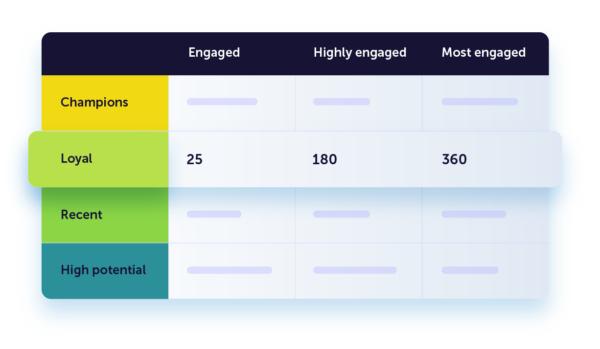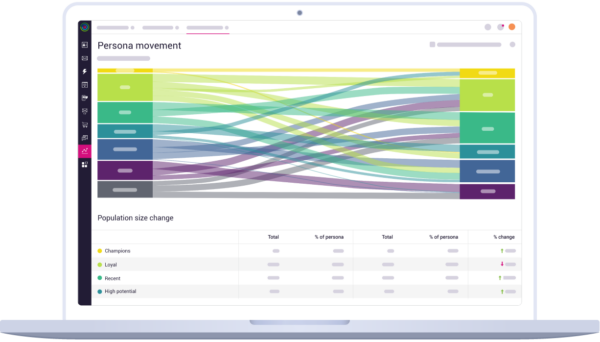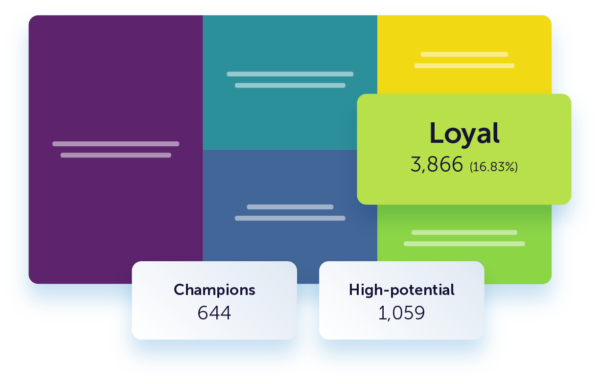Go beyond campaign goals with next-level segmentation
From optimized segments driven by analytics to lookalike audiences, Dotdigital empowers you to confidently build custom target audiences at any level.

Create meaningful moments for customers
Customer segmentation is the first step toward delivering truly personalized marketing. With Dotdigital's segment builder, the possibilities are limitless. Dive into your customer data to ensure you're targeting the right customer with the right message, or skip straight to Single customer view and create lookalike segments from there.

Surface your conversion-ready customers
Dotdigital makes behavioral modeling easy. We segment your customers into personas and overlay intent data. Using our intuitive segment builder, you can use these insights for customer segmentation and never again miss an opportunity to convert.

Unleash your segmentation strategy

Smart segmentation for personalized experiences
Intelligent segmentation helps unlock the hidden ROI in your marketing campaigns. Dynamic content blocks and smart program logic are just some of the ways you can deliver personalized content based on customer data.

Real-time insights to optimize your strategy
Use real-time analytics to ensure campaigns are optimized for ultimate ROI. Discover the click-through rate of a specific cohort, their most engaged day, average order value, RFM personas, and more. Compare metrics to understand what drives customers into action and where you can optimize to improve ROI.
Upgrade your marketing segmentation strategy
Frequently asked questions
What is segmentation?
Email segmentation involves splitting your email subscribers into smaller groups based on shared characteristics. This key email marketing tactic lets you send each group more relevant and customized content. You can create targeted segments based on your subscribers’ ages, demographics, behaviors, interests, or preferences so you can deliver messages tailored to their unique needs and preferences. If you don't segment your marketing list, you risk sending generic content to everyone, which can lead to subscribers disengaging because they don't find the information valuable.
What are the benefits of segmentation?
The benefits of segmentation in email marketing include improved open and click-through rates, higher customer engagement, increased conversions and sales, reduced unsubscribe rates, and better ROI. By targeting specific groups with relevant content, you can create personalized experiences that resonate with your audience, ultimately fostering stronger customer relationships and driving better results.
How to segment your email marketing list?
To segment your email marketing list, you should:
- Define your goals and objectives for segmentation
- Collect relevant customer data, such as demographics, preferences, and behavior
- Analyze the data and identify key customer groups or segments
- Create targeted marketing campaigns for each segment
- Continuously monitor, analyze, and optimize your segmentation strategy
Dotdigital’s intelligent segmentation tools make it easy for you to spot trends and similarities between your customers, making building segments quick and easy.
How do you segment an email marketing audience?
You can segment an email marketing audience by using different criteria, such as:
- Contact behavior: Based on past campaigns you have sent to contacts and how they responded and interacted with your communications.
- Data: Utilize first-party and zero-party data, including your contacts' shared details and their website interactions, to enhance segmentation. Consider factors such as demographics, interests, browsing patterns, and purchase history.
- Preferences: Leverage information from preference centers to categorize your contact lists based on their desired communication methods and content types.
- Ecommerce: Using in-depth ecommerce tools, you can build segments based on RFM, eRFM, purchase history, and more.
To learn more about how to segment your contact lists, read our blog on what is email segmentation.
What is an example of segmentation in email marketing?
An example of segmentation in email marketing could be organizing your customers into groups based on their past purchase history. For instance, you can categorize customers who bought skincare products, electronic gadgets, or fitness equipment separately. Then, create tailored email campaigns promoting specific, relevant products, offers, or tips for each segment. This targeted approach not only boosts engagement with your audience but also leads to higher conversion rates, as you deliver content that directly aligns with individual customers' interests and needs.
What is behavioral segmentation?
Behavioral segmentation is a method of dividing your customer base or email marketing list based on their actions, such as their browsing habits, past purchase history, or email engagement. This type of segmentation enables you to create targeted marketing messages that cater to each group's unique behaviors and preferences.
eRFM (engagement, recency, frequency, and monetary) is our ecommerce behavioral model designed to enhance customer segmentation by combining engagement scores with traditional RFM scores. Unlike standard RFM which focuses on purchase history, eRFM also considers customers' recent brand interactions.
With eRFM, you can identify personas ready for conversion and those needing re-engagement, enabling you to create personalized campaigns that improve customer retention. Through daily data syncing, your segments continuously update, reflecting your customers' changing behaviors.
This advanced approach ensures you never miss an opportunity to engage and convert customers.
To learn more about eRFM custom modeling, read our blog on eRFM.
What are the types of email segmentation?
The main types of email segmentation include demographic, psychographic, geographic, and behavioral segmentation.
- Demographic segmentation relies on zero-party data and categorizes subscribers based on characteristics like age, gender, income, and education level, allowing for tailored email content that resonates with diverse audiences.
- Psychographic segmentation utilizes first-party data to classify recipients according to their values, attitudes, interests, and lifestyles, leading to more relevant and persuasive email campaigns that align with individual preferences.
- Geographic segmentation involves grouping subscribers by geolocation, facilitating localized and region-specific email content that addresses unique regional characteristics and trends.
- Behavioral segmentation divides audiences based on browsing history, product interactions, and past purchases, allowing marketers to deliver customized email recommendations and promotions that align with user preferences.
What is demographic segmentation?
Demographic segmentation is the process of dividing your customer base or email marketing list based on specific demographic characteristics, such as age, gender, income, location, or education. This segmentation approach, which often relies on zero-party data, helps you create targeted marketing messages that appeal to the needs, preferences, and lifestyles of each demographic group.
How does marketing segmentation work?
Marketing segmentation works by dividing your contacts, users, or subscribers into groups based on specific criteria, which are determined by collecting and analyzing customer data. This process helps identify key characteristics and patterns that set apart different customer groups. This helps businesses to create tailored marketing messages and campaigns that cater to the needs and preferences of each group. By understanding and targeting these unique segments, companies can improve the effectiveness of their marketing efforts and achieve better engagement and conversion rates.
What is a good segmentation strategy?
A good segmentation strategy involves:
- Define your marketing goals
- Collect and analyze relevant customer data
- Create well-defined segments based on shared characteristics
- Design targeted marketing campaigns for each segment
- Continuously monitor, analyze, and optimize efforts for improved performance and efficiency
Dotdigital's customer experience and data platform (CXDP) unites customer data and simplifies advanced segmentation by streamlining the process of identifying trends and similarities among your customers, making it easier than ever to build, manage, and fine-tune targeted segments.